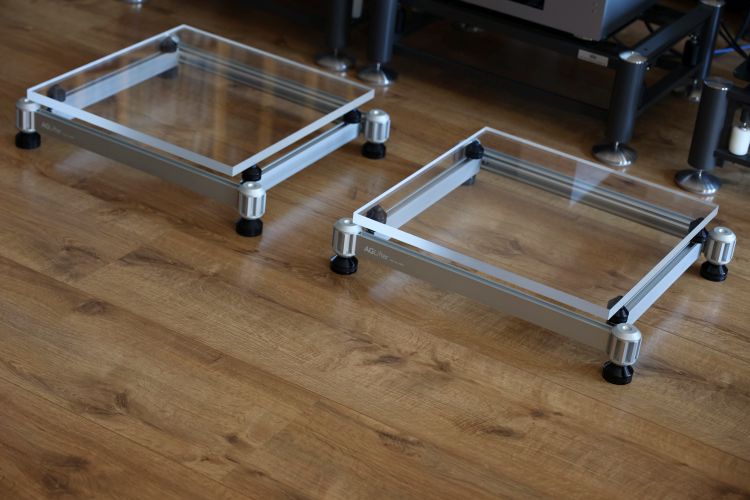
Review sample supplied by AG Lifter
Retail prices in the US (excl. freight and VAT):
Crescendo Power Amp Stand (with Dulcet 19 and 20 Footers): 3.700 USD (as reviewed)
Crescendo H.P.C. Brass Power Amp Stand (with Dulcet 19 and 20 H.P.C. Brass Footers): 4.950 USD
Available in Black and Silver finish and also available as a modular rack in 2, 3, and 4-shelf configurations. See the AG Lifter website for all options.
Preface
From my perspective, so far, New Zealand Audio Isolation Specialist AG Lifter seemed to fly under the radar in the Netherlands. I will admit to having only noticed their products first when gazing at the then-new Antipodes Oladra music server as it was photographed on top of an AG Lifter Apollo Audio Rack. As coincidence had it, Bob Prangnell of Mad Scientist (like AG Lifter a New Zealand-based company) later referred Andre Gil of AG Lifter to me for an in-depth review.
Shipping large and heavy racks from the other side of the world is a daunting undertaking. But as AG Lifter would soon be exhibiting at the Munich High End show together with Antipodes Audio, this created the ideal situation to ship the demo racks after the show from Munich to me in Amsterdam. And so it happened that I was sent a 3-tier Apollo Modular Rack plus Apollo H-Frame on top and two Crescendo Power Amp Stands in silver for review.
The two products will be discussed in separate reviews. This review will focus on the Crescendo Power Amp Stands and the Apollo Rack will be covered in a separate review.
About AG Lifter
As a part of AE Gil Technologies, AG Lifter is a 100% New Zealand Owned and Operated engineering-based company, born of over 35 years of experience in industrial engineering, design, and automation, with engineering capabilities extending into category one motorsport. Andre and Vanessa Gil, Company Directors, Audio Resonance Management Designers, and passionate music lovers, created AG Lifter out of a devotion to high-quality audio reproduction. They listen a lot to live music and judge their own product on its musicality with a lot of emphasis on the sound stage and the naturality of tone. The underpinning design philosophy was to build a rack for music lovers.
The original AG Lifter Mk 1 Isolation Foot was the catalyst for understanding the problems present in the Audiophile’s listening environment. At present day, the product is in its Mk 6 incarnation and this Footer alone went through over 40 changes from its conception. Out of wisdom gained from the development of this footer, the racks came into existence and in total, there are now seven AG Lifter Audio Rack models in different finishes.
AG Lifter audio isolation products are designed to be a mechanical diode that manages resonance from entering audio components, both externally but also internally. According to AG Lifter, it is a general misconception that harmful vibrations only enter audio equipment externally from the room. As the company points out, most harmonics are actually generated internally by the audio equipment itself.
AG Lifter Range
The AG Lifter audio rack range was designed to fit in with most contemporary and classic interiors. The Apollo Modular Rack is part of the premium range, followed by the Crescendo Modular Rack range. Both incorporate technologies that deliver their enhanced performance through the use of layers of isolation and coupling/decoupling. In addition, the Apollo Rack has an updated frame, which further optimizes the tunability of the rack. Furthermore, the High-Performance Coating (H.P.C), has been incorporated for the Apollo range of brass isolation components and coupling/decoupling.
The Crescendo Isolation System encompasses several layers of Isolation starting from the ground using the Dulcet 20 (Large) Isolation Feet. The module is then decoupled utilizing Stainless Steel bearings sitting in a billet CNC machined cap pressed into vertical custom extrusions. The 20-mm thick acrylic shelf is then isolated using the Dulcet 19 (Small) Isolation Feet. The Dulcet 19 Isolation Feet are adjustable in depth by simply unscrewing and re-tightening them by hand. They are also adjustable in width by loosening the Aluminum beams using an Allen key after which they can be freely positioned for fine-tuning. The frame is a custom-designed aluminum extrusion (ISO 9001) with aluminum billet caps, that dampen the extrusion. The custom extrusion is designed by AG Lifter and carries a patent covered by the New Zealand Aluminium Supplier. The pillar profile was designed to have the maximum amount of surface area to quickly release energy.
The end extrusion is born from extensive research and development, using different profiles, and a proprietary fastener is used to further apply tension to the extrusion. The aim was to achieve a dampened frame that is nevertheless “live” enough to provide exciting sound. Frame finishes are available in Black and Silver, including complimentary capping finishes.
The Crescendo range encompasses a Power Amp Stand (as reviewed), as well as a full rack solution. Its modular nature means that a user can start with a single-module 2-shelf solution and build out the system as needed. The rack can be ordered in a 2, 3, and 4-shelf version with a standard 240 mm of vertical equipment space. As standard, the outer dimensions of the frame are 600 mm x 500 mm. With 500 mm horizontally between the pillars in width, and basically unlimited free space in the rear so long as the component’s feet are supported on the 500 mm deep Acrylic platform, practically all audio equipment should fit comfortably. Additionally, the user can freely specify the desired pillar height to match the audio components used.
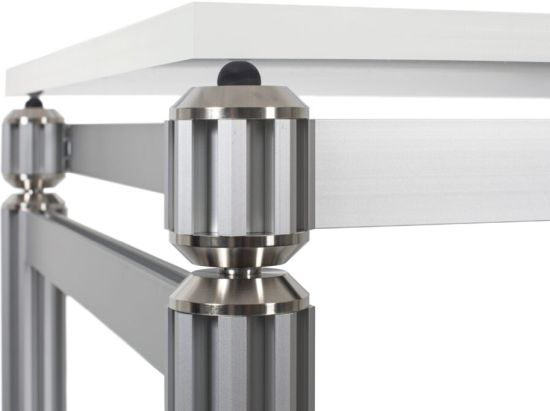
Isolation Technology
The AG Lifter design drains the harmonics from the audio equipment, dampens, and then transfers into the live frame dispersing the resonance in “real-time” through the AG Lifter proprietary alloy extrusion and pillar profile. The AG Lifter Racks are built to order and set up per the customer’s equipment, and the Acrylic platform supporting ball bearings are swapped out as needed for the designated audio component.
There are 2 types of bearings to support the Acrylic platter: REF 70 Rubber and 316 Stainless Steel.
Rubber REF 70 bearings are recommended to be used for the following equipment:
- Power Amplifiers
- Integrated Amplifiers
- Streamers (and Servers, I presume)
- Analog Turntables
- Power Supplies
316 Stainless Steel bearings are recommended for every other type of equipment, for instance, DA-Converters.
Considering that there is such a widespread sonic character among audio components, my feeling going into this review is that you cannot really divide components like this based on their product group alone. After all, one component may sound smooth and warm and another may sound hard or forward. Logic dictates that they will require different supports to obtain ideal system synergy. To find out, I simply set out to experiment with this using an extra set of bearings.
Extra bearings can always be ordered as needed, for instance, when one changes components or the rack’s composition.
Streamer or Server?
Although I find that more and more reviewers and companies are compounding servers and streamers into a single group and are calling them “streamers”, I prefer to refer to products like the Grimm MU1 and the Antipodes K50 or Oladra as Music Servers simply because they are not just Streamers, but also Servers. Technically, they are a server, streamer, and player all in one. A Streamer is a device that can only function as a streaming endpoint. In other words, it does not contain a physical music library component.
With that in mind and in light of the AG Lifter recommendation to use rubber bearings with streamers and steel for all other components, do the MU1, K50, and Oladra require rubber or steel bearings? In order to find out, I simply tried both options.
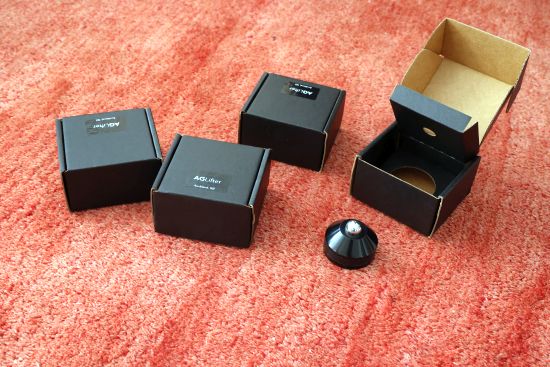
Dulcet Feet Versions
The AG Lifter Dulcet feet work according to the constrained-layer-damping technique and, depending on the Rack model, these are comprised of two layers of either Black Anodized Billet Aluminum or Billet Brass and a single layer of Custom Formulated, UV Resistant natural nitrile rubber isolation that is sandwiched in between. For the Crescendo Power Amp Stand feet, Aluminum is used, whereas, for the Apollo Rack feet, H.P.C Brass is used.
The Dulcet feet are supplied with each product in two size variants:
- Dulcet 19, which are the smaller platform-supporting feet.
- Dulcet 20, which are the larger rack-to-floor coupling feet.
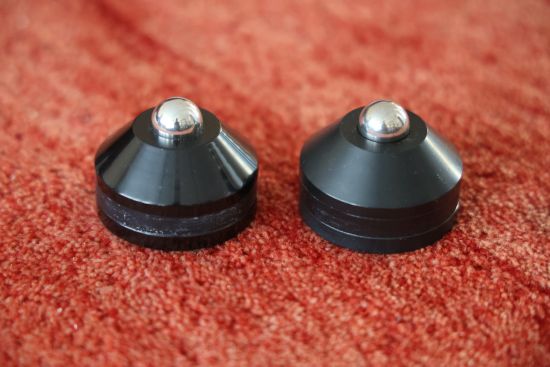
Left: Dulcet 20 Aluminum, Right: Dulcet 20 H.P.C. Brass. Note the Aluminum feet are lighter in weight and have a shiny finish while the H.P.C. Brass feet are much heavier and have a matte finish.
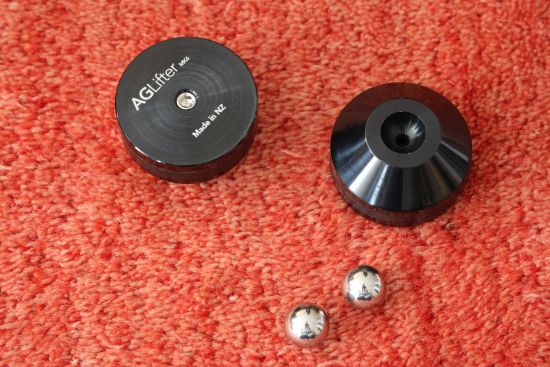
In this picture, the underside and cavity can be seen. Note the extra ball is from another footer. Each footer contains only a single ball.
Crescendo Power Amplifier Stand
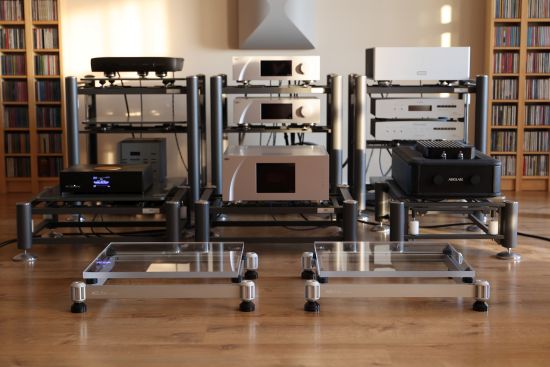
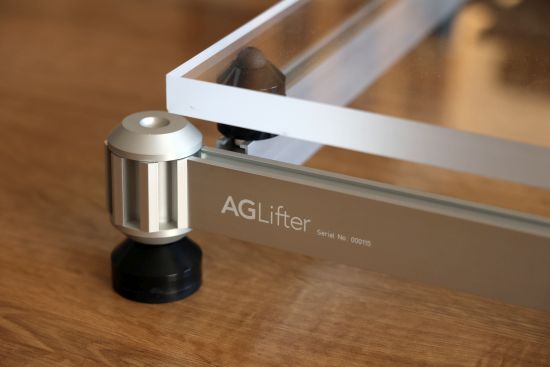
The Crescendo Power Amp Stand’s frame normally measures 500 x 600 mm. The Stands that I received were custom-built for the Munich Show and are slightly smaller than standard in order to fit on a demonstration desk. This neatly illustrates the stands’ multi-purpose aspect as they can be utilized on and in cabinetry, which works for clients who have antique or bespoke furniture that they wish to maintain while still desiring a sonic upgrade.
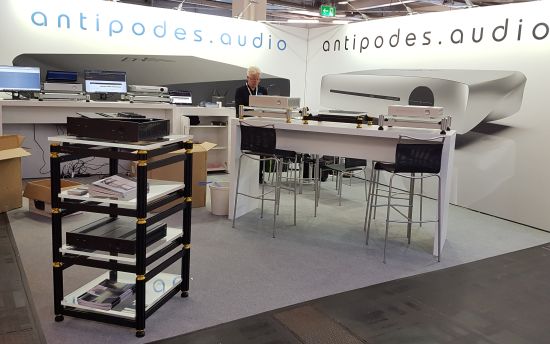
The Crescendo Power Amp Stand can optionally also be ordered with captive shelves (cut around the four pillars), as pictured below.
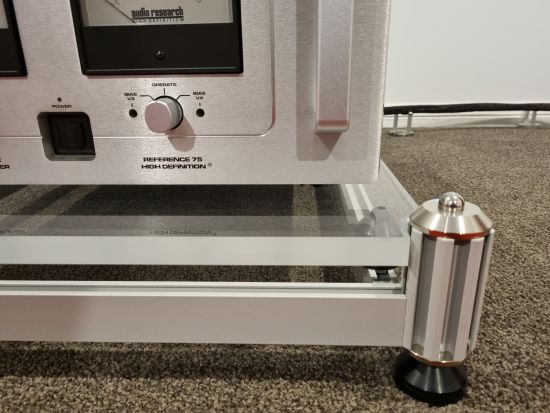
As standard, the Crescendo Power Amp Stands’ crossbeams are fitted with four Aluminum Dulcet 19 Isolation Feet to support the Acrylic platforms. On top of these feet, one can place either a Rubber or Stainless Steel Ball to interface with the Acrylic platform that supports the audio component.
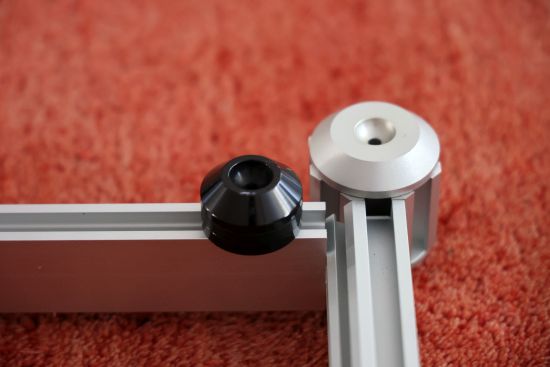
The Stand’s Dulcet 19 Footers can be freely positioned along the entire range of the aluminum beams. They are loosened or tightened simply by “unscrewing” and “screwing” them by hand. After setting the positions, the Acrylic platter is simply placed on top. The rubber bearings provide a very grippy support while the Stainless Steel bearings allow some movement with lightweight components. This is no longer the case when a very heavy weight such as the CH A1.5 amplifier is placed on top.
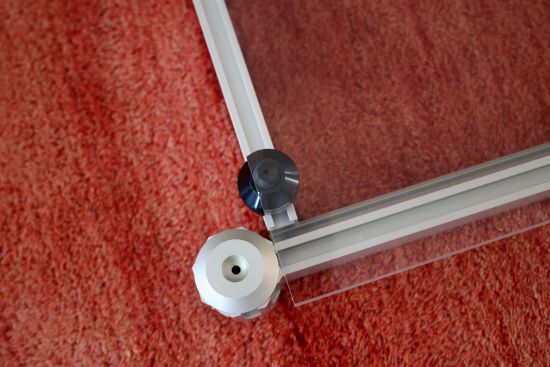
Next: Review Context and Listening
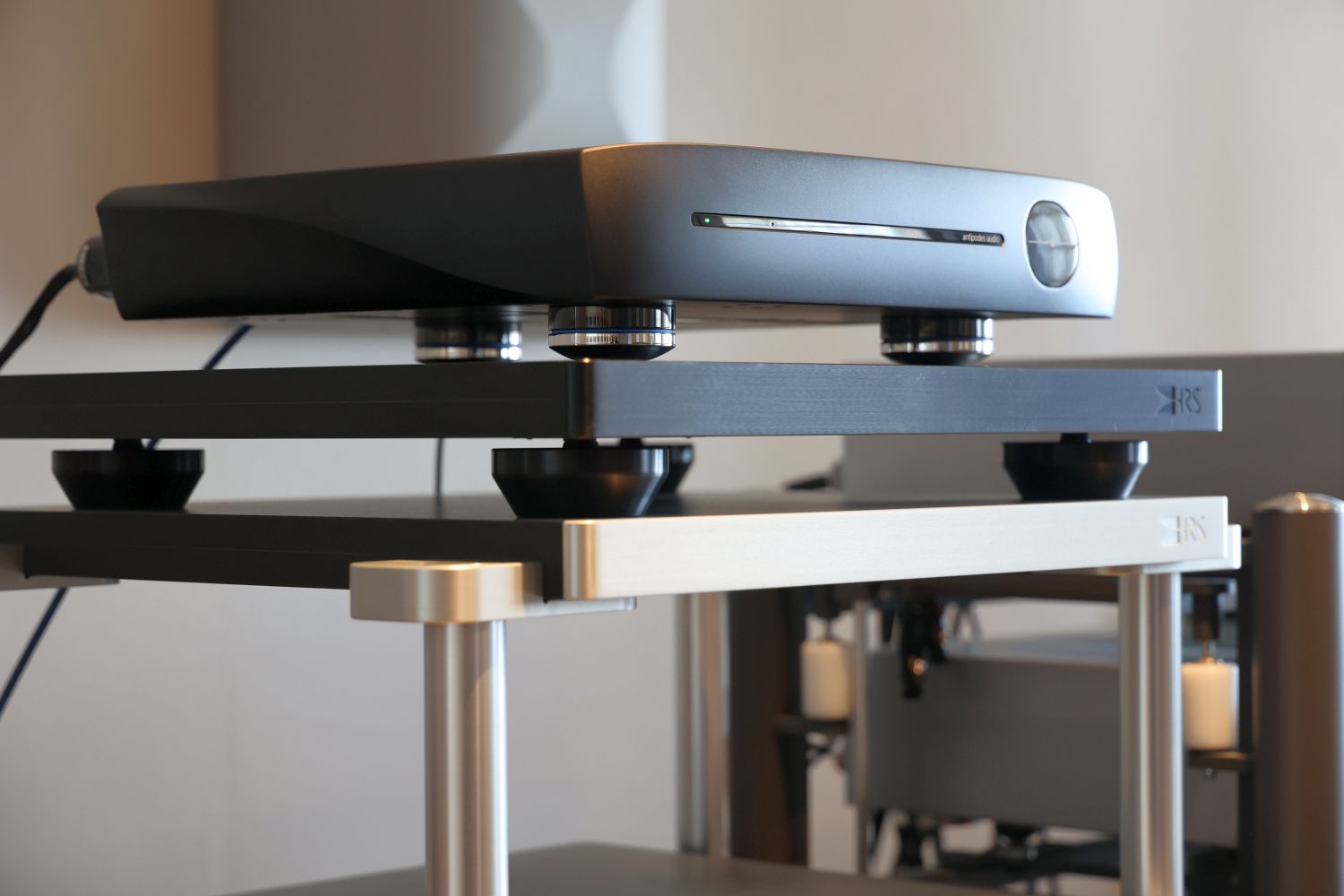


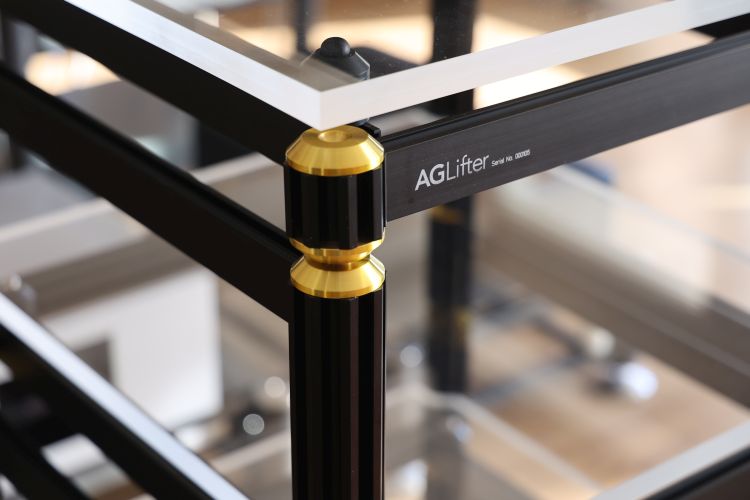
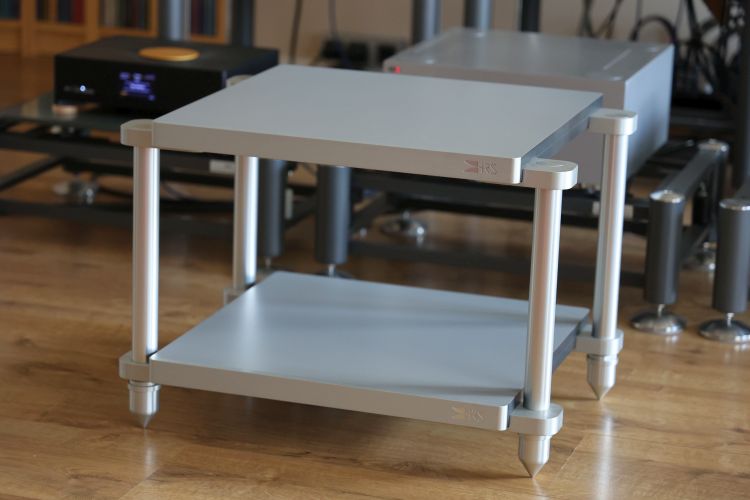
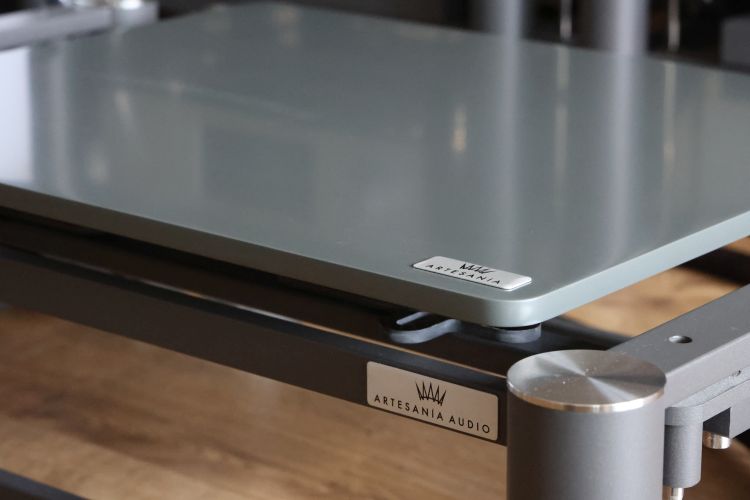
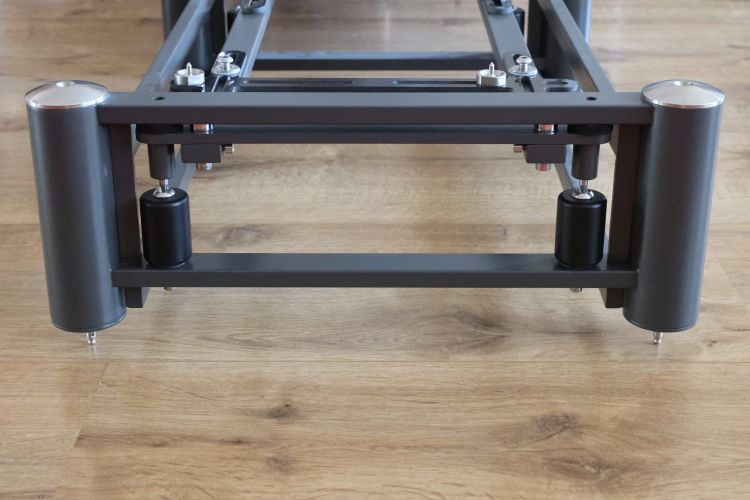
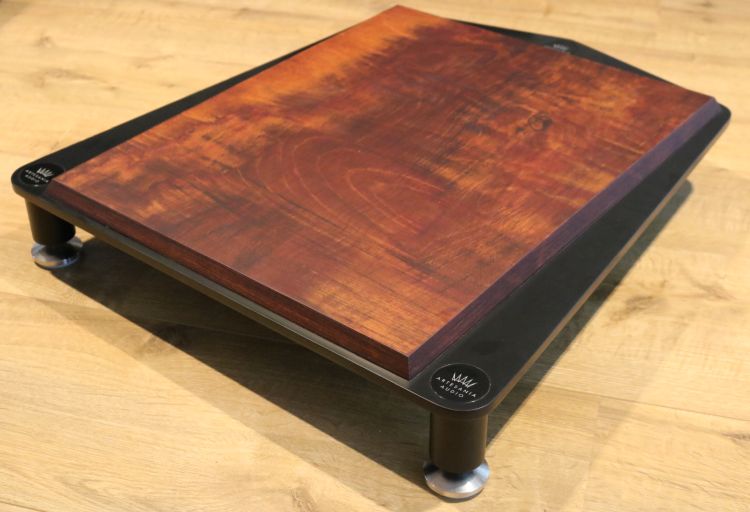
$5k for acrylic ?
Madness !